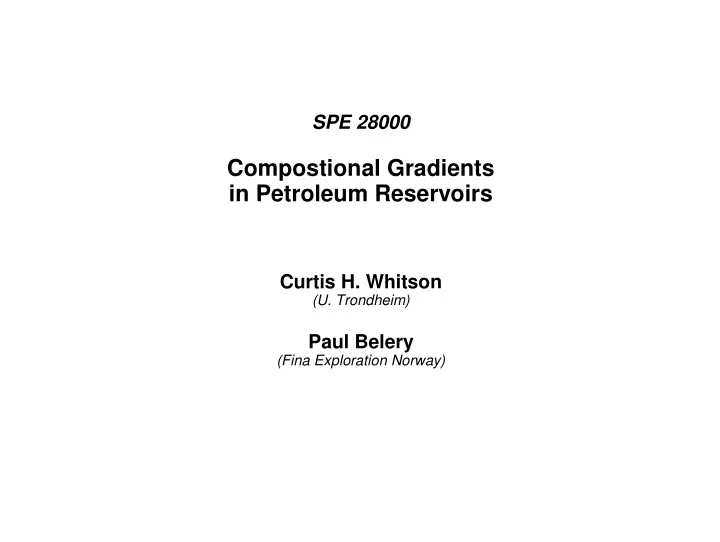

SPE 28000 Compostional Gradients in Petroleum Reservoirs Curtis H. Whitson (U. Trondheim) Paul Belery (Fina Exploration Norway)
Compositional Gradients When & Why Are They Important? � Determining Original Hydrocarbons (IOIP/IGIP) � � � Needs to be done a component basis � Sampling Procedures and Test Interval Selection � � � � Reservoir Development Strategy � � � Producer/Injector Well Placement
Compositional Gradients When & Why Are They Important? � Design of Miscibility Criteria for Gas Injection � � � � Design of Process Facilities � � � � Choice of Reservoir Simulation Model � � �
Literature Review 1800s � � Gibbs Fundamental Theory � � 1930 � Muskat Theory/Simple Examples � � � 1938 � Sage and Lacey Theory/Simple Examples � � � 1980s � � Schulte Theory/Case History � � � Holt et al. Thermal/Gravity Theory � � � � Hirschberg Asphaltenes/Tar Mat � � � � Riemens et al. Oman Case History � � � � Montel and Gouel Algorithm/Analysis � � � � Metcalfe et al. Anschutz Case History � � � � Creek and Schrader Overthrust Case History � � � ... others Case Histories 1990s � � Belery and da Silva Thermal/Gravity Theory & � � Application � Wheaton Gravity/Capillary � � � � Montel Theory/Examples � � � � Bedrikovetsky (Pavel) Theory/Simple Examples � � � � Faissat et al. Thermal/Gravity Theory � � �
Compositional Gradients Where Are They Found? � Thick Oil/Gas Reservoirs � � � � Oil/Gas Reservoirs with Significant Structual Relief � � � � Volatile and Near-Critial Oil/Gas Reservoirs � � � � Saturated or Slightly Undersaturated Reservoirs � � � � All Over The Place! � � �
Isothermal Gravity/Chemical Equilibrium (GCE) µ i (p o ,z o ,T) = µ i (p,z,T) + M i g (h-h o ) µ i = chemical potential of i g = acceleration due to gravity M i = molecular weight of i � T = temperature (constant) � � � � h o = reference depth � � � � p o = pressure at reference depth h o � � � � z o = composition at reference depth h o � � � � h = any depth � � � z = composition at depth h p = pressure at depth h
GCE Solution Algorithm Equilibrium/Constraint Conditions ( µ i =RT ln f i + λ i ) o g(h- ) M h i o (h) = ( ) exp[- ] , i = 1,2... N f f h i i RT N (h) = 1 z i i ∑ = 1
GCE Solution Algorithm Solution Function N Q(p, z) = 1 - Y i i ∑ = 1 o o o ( p , ) g(h- ) f z M h i i = [ ] exp[- ] Y z i i (p, z) RT f i � Accelerated Successive Substitution for z(h) � � � � Newton-Raphson for p(h) � � �
Example Applications � BO Black Oil / Very Lean Gas � � � � SVO Slightly Volatile Oil / Lean Gas Condensate � � � � VO Volatile Oil / Rich Gas Condensate � � � � NCO Near Critical Oil / Near Critical Gas � � �
Phenomena Studied � Degree of Undersaturation � � � � Heptanes-Plus Split � � � � Volume Translation � � � � "Passive" Thermal Gradient � � � � Thermal Diffusion � � � � EOS Fluid Characterization � � �
Developing an EOS Fluid Characterization � Use ALL Reservoir-Representative Samples & � � � PVT Data Develop a Single EOS Fluid Characterization with � � � � Consistent Treatment of C 7+ � Tune EOS to Match ALL Reliable/Quality PVT � � � Data Simultaneously (particularly compositional data)
Thermal Diffusion Effects � Formal Thermodynamic Treatment of Thermal � � � Diffusion is Lacking Several Zero Net-Mass-Flux Solutions are Available - Which to Use? � Thermal Diffusion Can Enhance, Reverse, or � � � Balance (Methane) Compositional Gradients Caused by Gravity/Chemical Equilibrium
Thermal Diffusion Effects (continued) � Convection may Result from Thermally-Induced � � � < 0 Downward Movement of Methane ( k ) T C 1 d ln T dz i = - k Ti dh dh � Convection Problem Can No Longer be Solved in � � � One Dimension; Very Complicated
Key Conclusions 1. Expected Saturation Pressure Gradients Range from 0.025 bar/m to 1.0 bar/m (0.1 to 4.5 psi/ft) 2. Dewpoint and Bubblepoint Gradients are Approximately Symmetric in Saturated Systems 3. Compositional Gradients Decrease at Increasing Degrees of Undersaturation 4. An Efficient Algorithm is Given for Solving the Gravity/Chemical Equilibrium Problem.
Key Conclusions (continued) 5. Special EOS Characterization Techniques are Required to Properly Characterize Reservoirs with Significant Compositional Gradients 6. Thermal Gradients May Enhance, Reduce, or Balance Gravity-Induced Compositional Gradients (particularly for Methane) 7. A Formal Thermodynamic Treatment of Thermal/Gravity/Chemical "Equilibrium" Does Not Presently Exist
MOLAR COMPOSITIONS & PHYSICAL PROPERTIES Slightly Near Component/ Black Volatile Volatile Critical Property Oil Oil Oil Oil N 2 0.262 0.270 0.930 0.550 CO 2 0.367 0.790 0.210 1.250 C 1 35.193 46.340 58.770 66.450 C 2 3.751 6.150 7.570 7.850 C 3 0.755 4.460 4.090 4.250 iC 4 0.978 0.870 0.910 0.900 C 4 0.313 2.270 2.090 2.150 iC 5 0.657 0.960 0.770 0.900 C 5 0.152 1.410 1.150 1.150 C 6 1.346 2.100 1.750 1.450 C 7+ 56.226 34.380 21.760 13.100 M 7+ 243 225 228 220 γ 7+ 0.8910 0.8700 0.8559 0.8400 Reference Conditions h o (m) 1550 2635 3160 3049 o C) T ( 68 95 130 132 o (bara) p 160 263 492 483/469 p b (bara) 160 246 383 462 3 /Sm 3 ) GOR (Sm 62 156 299 560 γ o (water=1) 0.887 0.860 0.825 0.827
Recommend
More recommend